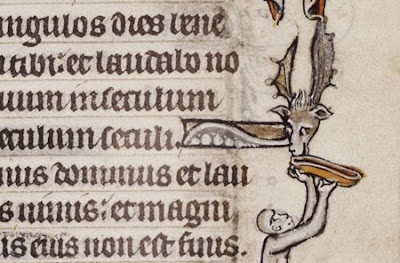Last week, I posted a picture of a superheroic monkey that reminded some readers of a superheroic blogger, Cory Doctorow of BoingBoing. I’ll let you be the judge:

I’ll admit, the resemblance isn’t exact. But the dark circles around the eyes, the shape of the head, and those ears are all suggestive. In the interest of art history, I suggest Cory remove his pants and pose with a long stick so we can be more exact with the comparison. If you don’t know who Cory Doctorow is, or why he wears a cape and goggles, go read the xkcd comic that started that particular meme.
OK, back? Now for for this week’s marginalia. I’m not 100% sure on this, but I think I’ve found further compelling evidence of medieval time travel. Why else would a 13th-century illuminator plant this caricature of Tony Blair in the manuscript’s margin:

Most people I’ve shown this one to agree that the likeness is spot-on… until I place it side by side with an actual picture of Tony Blair, and then they’re less wowed. Like so:
Nevertheless, I remain convinced. Look at the eyebrows, the shape of the nose, and the teeth. Granted, former Prime Minister Blair does not have a tongue that spirals out into an acanthus leaf, and his tail is much less pronounced. Also, the marginal image is clearly many years younger–but this is time travel we’re talking about. Either the young Blair had a glorious adventure he hasn’t yet revealed to the world,* or the medieval illuminator traveled forward to 1980 or so. It’s hard to say for certain. Either way, I smell a new book for Dan Brown.
—
*It could happen. Look how long it took him to fess up to being Catholic.









Recent Comments